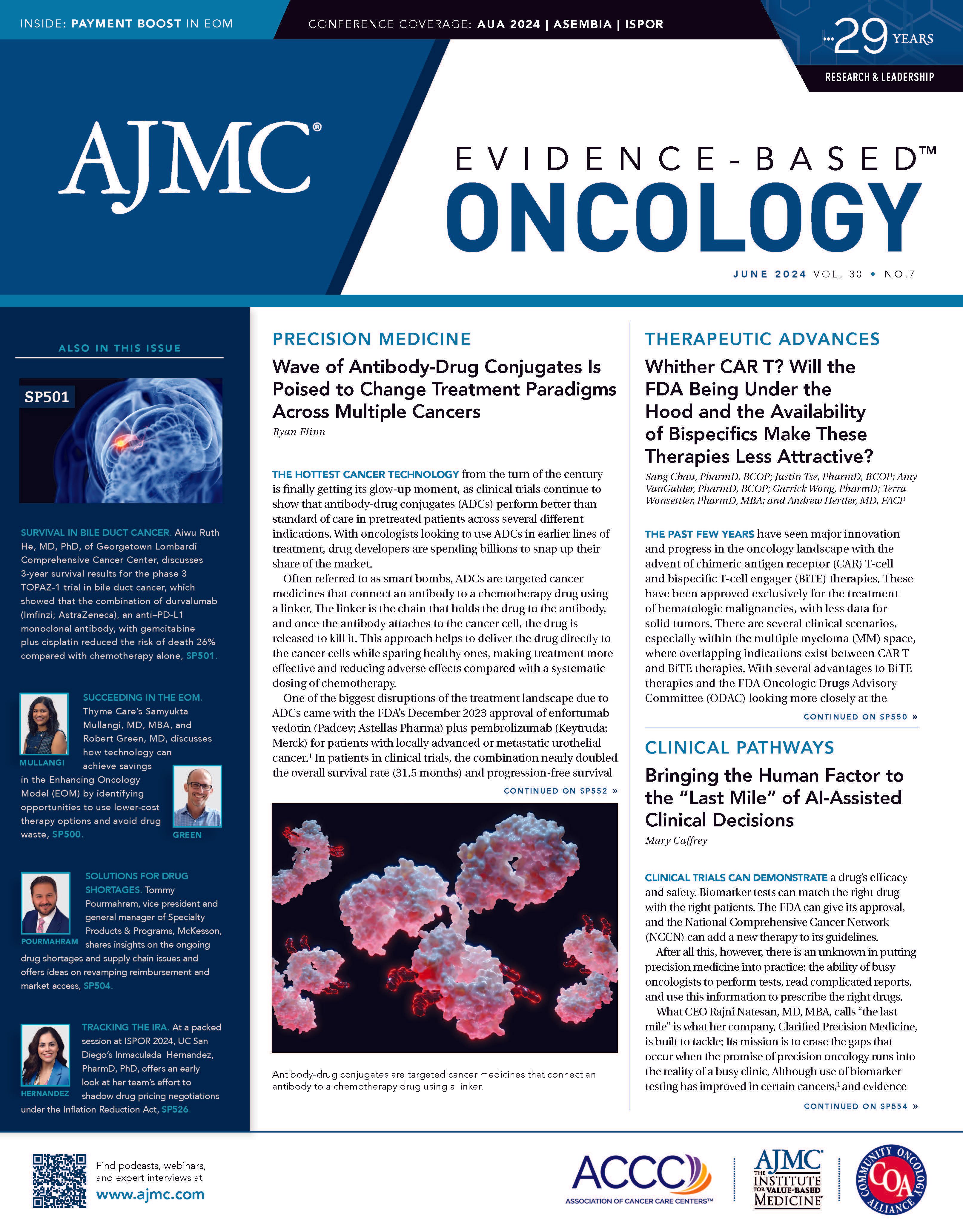Publication
Article
Evidence-Based Oncology
CMS Reopens EOM With Payment Boost, Extends Model to 2030
Author(s):
Key Takeaways
- CMS increased MEOS payments to $110 PPPM, with a maximum reimbursement of $140, still below the OCM level of $160.
- The EOM model's duration is extended to June 2030, with a new cohort starting in July 2024.
The Enhancing Oncology Model (EOM) attracted fewer participants than its predecessor, with lower payment rates cited as a chief factor.
On May 30, 2024, CMS announced updates to the Enhancing Oncology Model (EOM),1 responding to concerns oncologists raised a year ago when they said the smaller payments available under the successor to the Oncology Care Model (OCM) were not enough to justify the added work.2,3
Their warnings were borne out when only 44 practices signed up as of July 1, 2023, compared with 122 that were still in the OCM when that model expired in June 2022 (of note, multiple sites that are part of the American Oncology Network are listed as a single practice).4 The overall penetration of the EOM is below expectations,5 which has raised concerns about both the future of value-based models in Medicare as well as CMS’ ability to someday impose a mandatory model if practices are not well-versed in the nuances of this type of care delivery.
Under the changes, applicants can sign up for the EOM starting in July 2024, with the intent of starting in the model in July 2025. The model was scheduled to end in June 2028 but has now been extended to June 2030.1
In addition, CMS will raise the basic Monthly Enhance Oncology Services (MEOS) payment level from $70 per patient per month to $110 PPPM. Under the existing model, practices could receive an additional $30 per month for patients who were dually eligible, and this continues. Thus, the maximum potential reimbursement is $140 per patient, still below the OCM level of $160.
“In adding a second cohort of participants, extending the model, and updating payment policies, more patients undergoing cancer treatment and their families will have access to the enhanced services offered under the model and high quality of care,” CMS said in a statement on the web site. "More members of the oncology community will be able to help CMS shape the future of cancer care.”
CMS also made an important change to how EOM practices can earn performance-based payments. Practices must meet “a risk-adjusted spending target for their attributed episodes” and will owe CMS money if their spending exceeds a percentage of the benchmark. Under the changes announced today, CMS increased that threshold from 98% of the benchmark amount to 100% for all episodes starting January 1, 2025.
This is a key change for practices that started in the OCM and have already achieved significant efficiencies; otherwise, it would become increasingly difficult to avoid paying penalties to CMS.
Many Saw Changes Coming
Changes to the EOM and a new round of applications have been anticipated for months. The model followed the basic framework of the OCM, built around 6-month episodes of care. However, there were key differences, including:
- It only applied to 7 common cancers instead of nearly all cancers
- It requires practices to collect information on, and develop plans to address, patients’ health-related social needs.
Besides the reduced MEOS payments, some oncologists said limiting the model to only 7 cancers could create challenges in practices that had transformed all their care to align with high level required under the OCM. Physicians said it was not ethical to offer navigation services to some patients but not others based on their cancer diagnosis, for example. But without payments to cover staffing costs, it would be difficult to keep up the services.
Compared with the OCM, the EOM was more likely to attract practices that were part of well-established managed services organizations such as The US Oncology Network or OneOncology. Still, there were some high-profile practices that stayed out of the EOM a year ago, including Florida Cancer Specialists & Research Institute and The Center for Cancer and Blood Disorders, based in Fort Worth, Texas. A well-known small practice that stayed out of the EOM was Carolina Blood and Cancer Care Associates, led by Kashyap Patel, MD, a former president of the Community Oncology Alliance.
In addition to increasing the MEOS payments, CMS has in the past year created a reimbursement stream for patient navigation, a service required by the EOM. Although many welcomed recognition of the value of navigation, others note the payment scheme has challenges. It requires the trained navigator to be engaged with the patient for a full hour, a duration that many say is not aligned with how these services are delivered in a real practice setting.6 However, there is the potential for some costs of the EOM to be paid under a different mechanism.
References
1. Enhancing Oncology Model. CMS. Accessed June 4, 2024. https://www.cms.gov/priorities/innovation/innovation-models/enhancing-oncology-model
2. Patel K. EOM payments are not sufficient to achieve health equity goals. Am J Manag Care. 2023;29(4 Spec No.):SP330.
3. Caffrey M. Amid concerns, will practices take part in the Enhancing Oncology Model? Am J Manag Care. 2023;29(4 Spec No.):SP328.
4. Caffrey M. Final tally lists 44 practices in EOM, but it's complicated. AJMC®. July 12, 2023. Accessed June 4, 2024. https://www.ajmc.com/view/final-tally-lists-44-practices-in-eom-but-it-s-complicated
5. Lyss A, Abrams J, Young G, et al. Why EOM participation was extremely low—and how to fix it. Am J Manag Care. 2023;29(9 Spec No.):SP882.
6. Mullangi S. Policy change puts dollars and common sense behind patient navigation in oncology. Oncology News Central. February 6, 2024. Accessed June 4, 2024. https://www.oncologynewscentral.com/article/policy-change-puts-dollars-and-common-sense-behind-patient-navigation-in-oncology






